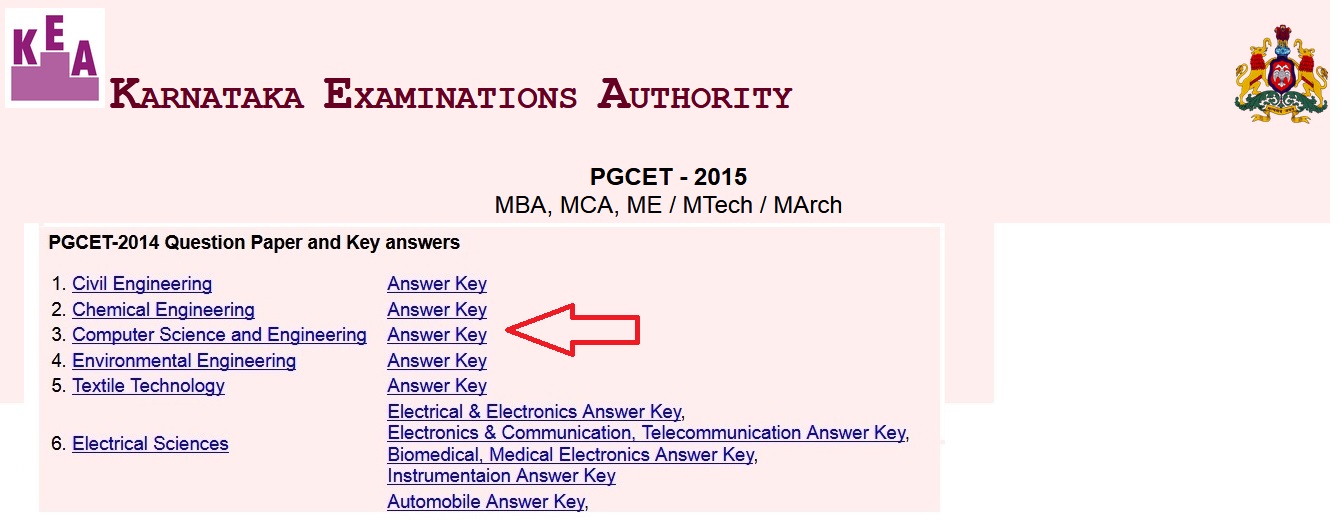kea.kar.nic.in PGCET Electrical Sciences Question Paper : Karnataka Examinations Authority
Name of the Organisation : Karnataka Examinations Authority
Name of the Exam : Common Entrance Test
Subject: Electrical Sciences
Year : 2015
Document Type : Question Paper
Website : https://cetonline.karnataka.gov.in/kea/indexnew
Download Model Question Paper :
Electrical Sciences 2010 : https://www.pdfquestion.in/uploads/13536-Electrical2010.pdf
Electrical Sciences 2011 : https://www.pdfquestion.in/uploads/13536-Electrical2011.pdf
Electrical Sciences 2013 : https://www.pdfquestion.in/uploads/13536-Electrical2013.pdf
Electrical Sciences 2014 : https://www.pdfquestion.in/uploads/13536-Electrical2014.pdf
KEA PGCET Electrical Sciences Question Paper
Time: 2 Hours
Max. Marks: 100
Related : Karnataka Examinations Authority PGCET Mechanical Science Question Paper : www.pdfquestion.in/13533.html
Instructions
Read the following instructions before answering the test :
** Write / Darken the particulars of your identity, Test Seat Number and fix your signature on the OMR Response Sheet before the start of the ” test.
** All Questions have multiple choices of answers, of which only one is correct.
** Mark the correct answer by completely darkening only one oval against the Question number using Black Ink Ball Point pen only.
** There will be no negative evaluation with regard to wrong answers.

** Marks will not be awarded if multiple answers are given.
** Do not make any stray mark on the OMR Response sheet.
** For rough work, use blank page on the question paper.
** Taking the question paper out of the test hall is permitted only after then full duration of the test.
** Use of only non-programmable calculator is permitted.
** Start Answering Only At The Specified Time When The Invigilator Gives Instructions.
Marks Distribution
PART — A :
Section —I 30 Questions : 30 x 1 = 30 Marks
Section – II 15 Questions : 15 x 2 = 30 Marks
PART — B :
Section —I 20 Questions : 20 x l = 20 Marks
Section – II 10 Questions : 10 x 2 = 20 Marks
Total = 100 Marks
Model Questions
1. The rise time Tr for c(t) = 1 — e_t is given by
a. 1.198
b. 2.198
c. 2.298
d. 3.298
2. A soft error in DRAM
b. cannot be corrected
a. cannot be recovered
d. none of the above
c. can be recovered by reprogramming
3. The The venin’s equivalent for the network in Fig. l
a. -502.5mV, 400.59
b. 502.5mV,-100.59
c. – 502.5mV, 100.59
d. 100.5 m_V, 502.59
4. The loaded voltage gain of an amplifier is always
a. Less than no load gain
b. more than no-load gain
c. equal to no-load gain
d. none of the above
5. The high and low cut-off frequencies of an amplifier can_be determined by the response of the system to
a. sinusoidal input
b. square wave input
c. triangular wave input
d. pulsed input
6. The number of machine cycles and T states required for execution of STA instruction are
a. (3, 12)
b. (4, 12)
c. (4, 13)
d. (3, 13)
7. The following program results in
LXI SP, 27FEH
PUSH B
PUSH D
POP B
POP D
a. exchanges contents of BC and DE
c. exchanges contents of BD and CE
b. stores original contents of BC and DE in stack
d. stores contents of only BC in DE
8. The following‘is not a vectored interrupt
a. TRAP
b. RST 5.5
c. INTR
d. RST 7.5
9. The vector address for RST4 is
a. 0018B
b. 002011
c. 0028H
d. 003011
10. The open loop gain of an amplifier is 100. If negative feedback with B = 0.1 is used the closed loop gain will be
a. 111.1
b. 90.9
c. 0.09
d. none of these
Electrical Sciences – 2014 :
Section – 1 :
** Each question carries one mark. ‘ (30 x 1 = 30)
1. In an amplifier, the output current flows for 200° of input cycle. The class of operation of the amplifier is –
(A) A
(B) AB
(C) B
(D) C
2. In an RC coupled CE amplifier, typical value of coupling capacitor is
(A) 1000 pF
(B) 0.1 nF
(C) 10 uF
(D) 0.01 uF
3. The common collector amplifier is also called emitter follower because
(A) Emitter current follows the collector current
(B) Emitter voltage follows the collector voltage
(C) Emitter voltage follows the“ base signal voltage
(D) Emitter current follows the collector voltage
4. In a JFET, dynamic drain resistance, rd is of the order of
(A) 1 kn
(B) 10 m
(C) 100 kg
(D) 100 M9
5. Frequency distortion in an amplifier is caused by
(A) Non—linear dynamic characteristics of the active device
(B) Reactive elements in the circuit
(C) Ripple components in the circuit
(D) High temperature of operation
6. In a class B push pull amplifier, ratio of the maximum collector dissipation to maximum AC power output is about ‘
(A) 0.25
(B) 0.4
(C) 0.5
(D) 0.75
7. In a negative feedback amplifier, voltage sampling:
(A) Tends to decrease the output resistance
(B) Tends to increase the output resistance
(C) Does not alter the output resistance
(D) Produces the same effect on the output resistance as current sampling
8. Rectification efficiency of a full wave rectifier without filter is nearly equal to
(A), 51%
(B) 61%
(C) 71%
(D) 81%
9. The ‘Slew rate’ of an operational amplifier indicates
(A) How fast its output current can change.
(B) How fast its output impedance can Change.
(C) How fast its output power can change.
(D) How fast its output voltage can change when a step input signal is applied
10. In IC technology, dry oxidation (using dry oxygen) as compared to wet oxidation
(using steam or water vapour) produces –
(A) Superior quality oxide with a higher growth rate
(B ). Inferior quality oxide with a higher growth rate
(C) Inferior quality oxide with a lower growth rate
(D) Superior quality oxide with a lower growth rate